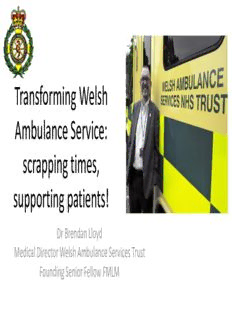
Transforming Welsh Ambulance Service PDF
Preview Transforming Welsh Ambulance Service
Transforming Welsh Ambulance Service: scrapping times, supporting patients! Dr Brendan Lloyd Medical Director Welsh Ambulance Services Trust Founding Senior Fellow FMLM Dr John Kotter: “Leading Change” 8-stage process to creating major change Our ‘Burning Platform’ - 2013 Operating Context • Increasing demand and acuity • Financial constraint / resourcing gap • Deteriorating performance • Flawed operating / performance model • Frequent senior management turnover • Weaknesses in corporate governance • Challenging industrial relations climate • Talented but disengaged workforce • Intense political and media scrutiny • Repeated review and re-organisation • Doubt about the organisation’s future The Problem: Contacts 2013/14 • 999 – 420,000 calls CALL TYPE CATEGORY & CODE (MPDS) RED 1 (~3%) • 40% or 166,000 RED 1&2 ≤ 8 min (Echo and high end Delta codes) CATEGORY • 86,000 HCP – 25,000 RED A RED 2 (~35%) ≤ 8 min • RED: multiple dispatches (Delta and high end Charlie codes) GREEN 1 & 2*(~40%) • 317,000 NHS Direct Face to Face≤ 20 min (Charlie & Bravo codes) CATEGORY • 3m website hits C GREEN 3 (~22%) Call Back CTA≤ 10 min or Face to Face ≤ 30 min • 1m PCS Journeys (Alpha & Omega codes) Designing ambulance into unscheduled care Conditions for Change – Health Policy Clinical Response Model CATEGORY RESPONSE MODE DEPLOYMENT MEASURES Blue lights Multiple Resources 65% within 8 minutes RED ≤ 8 minutes ( 60-70 calls per Ideal/Suitable day out of 1300) Blue lights Right clinician/resource Clinical Interventions AMBER Ideal/Suitable in a timely manner, based Patient Outcomes (65%) on clinical need. Hear and Treat Planned non-emergency Clinical Outcomes GREEN Normal Road Speed transport (ambulance/taxi): Patient Satisfaction (30%) Telephone advice / clinical assessment SIMPLE …… CLINICALLY FOCUSED…... PRUDENT …… SAFE
Description: